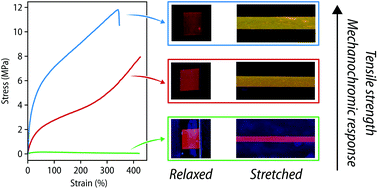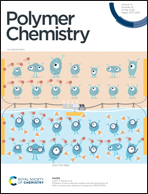Strain-correlated mechanochromism in different polyurethanes featuring a supramolecular mechanophore†
Abstract
A previously reported, supramolecular, loop-forming mechanophore comprised of two covalently connected perylene diimide (PDI) dyes was equipped with hydroxy groups and covalently incorporated into different polyurethanes (PUs). Four PUs with different hard segments based on either isophorone diisocyanate (IDI), 4,4′-methylenebis(cyclohexyl isocyanate) (HMDI), hexamethylene diisocyanate (HDI), or methylene diphenyl diisocyanate (MDI) were investigated. The different isocyanates affect the degree of hard phase formation and crystallization, and thus bestow the materials with different mechanical properties. Except for the MDI-based polymer, whose photoluminescence is quenched, dominant excimer emission is observed for all polymers in the absence of mechanical force, which indicates that the mechanophore motif is folded into a loop with interacting PDI dyes. Upon deformation, the PDI monomer emission intensity increases to the extent that the change becomes visually discernible, suggesting that the loops unfold. The mechanophore functions well in all three matrices, but the mechanochromic response depends strongly on the polymers’ materials properties. The most pronounced response is observed for the HDI-based PU, which displays a robust hard segment formation and the highest strength and stiffness. In all materials, the mechanochromic response reliably scales with the applied strain and reversible strain sensing over multiple cycles of deformation could be shown for all PUs.



 Please wait while we load your content...
Please wait while we load your content...